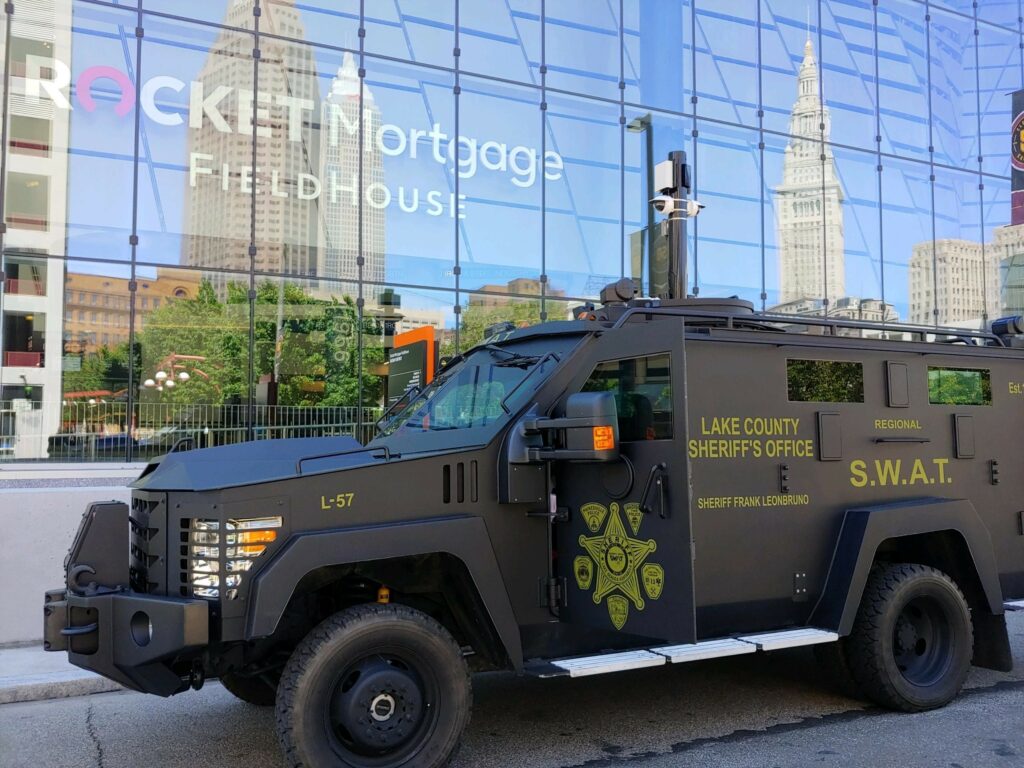Special Weapons & Tactics (SWAT)

The Lake County Sheriff’s Office SWAT Team was formed in the 1970’s and was the first to exist in Ohio. It employs sophisticated equipment and maintains a rigorous training schedule on negotiations techniques, chemical agent deployment, tactical paramedic training, long-rifle shooting, less then lethal weaponry, and covert building searches. The Lake County Sheriff’s Office SWAT Team maintains the ability to respond to high risk incidents at any hour of the day or night, regardless of weather. The unit is on a 24-hour call-out basis at all times.
The SWAT team is generally activated to respond to situations that are deemed high risk and/or require specialized training, expertise and equipment. The SWAT Team is committed to the safe resolution of all critical incidents and approaches each situation in a professional and controlled manner, with an emphasis on a negotiated resolution.
The primary functions served by the team include:
- High-Risk search and arrest warrants
- Barricaded subjects
- Hostage taking incidents
- Suicidal individuals
- Riot/civil disturbances
- Officer rescue
- Surveillance operations
- Dignitary protection/ VIP visit
Incidents involving barricaded subjects, hostage takers, or persons threatening suicide represent especially trying and stressful moments for law enforcement personnel who respond to them. Officers first responding to the scene must quickly assess the totality of the situation, secure the area, gauge the threat to hostages or bystanders, and request additional units as appropriate. Crisis negotiators must establish contact with subjects, identify their demands, and work to resolve tense and often volatile standoffs without loss of life. Special Weapons and Tactics (SWAT) teams must prepare to neutralize subjects through swift tactical means. Although it might appear that negotiators and tactical teams work at cross-purposes during a crisis, nothing could be further from the truth. Society requires that law enforcement exhausts all means available prior to launching a tactical resolution to an incident. If these means prove unsuccessful, then the transition from negotiation to tactical assault must be a smooth one.
SWAT is made up of highly skilled officers, each of whom can assume varied responsibilities with a high degree of expertise and proficiency. The unit is prepared to assume full control of specific tactical situations which, by nature, would be considered excessively dangerous and complex, or which would require the use of a specialized team effort rather than independent action by individual officers. Practically speaking, the unit is organized as a crisis intervention team with both negotiation and assault capabilities. Negotiations initiated by the unit employ modern psychology and negotiation techniques. Stress, logical reasoning, time, utility control, barter and other concepts, tools and devices might be used to ease a crisis. Assault tactics employed by the unit reflect police strategy of handling and dealing with situations involving confrontations with potentially dangerous suspects. The concept of “apprehension of the suspect” is accomplished through the primary discipline of approaching each situation as a “life saving mission”.

HISTORY
In June of 1974, Lt. Charles Caldwell of the Lake County Sheriff’s Office attended the 98th Session of the FBI National Academy in Quantico, Virginia. Two of the courses that he took while attending the National Academy were the Formation of SWAT Teams and Training and Funding of SWAT Teams. SWAT (Special Weapons and Tactics) teams were a new concept in the United States at that time and probably no more than 50 of them were in existence. The Los Angeles City Police Department has been credited with starting the first SWAT team in the United States and putting forth the idea that such a specialized team could be used when necessary to help the normal police operation in dealing with barricaded suspects or other types of violent activity that were above the normal daily activity of uniform patrol divisions. The course that Lt. Caldwell took consisted of daily training classes for a period of three (3) months. The instructor for this course at the FBI National Academy was David J. Kriskovich who was the head of the newly formed FBI SWAT team which he is credited with helping to start. Kriskovich was a former Army Green Beret and was skilled in the tactics of small fighting units and interdiction teams into critical areas as used in the military. The newly formed SWAT concept in this early period was based on military tactics. This course at the FBI National Academy had 50 students from all over the United States.
The concept of SWAT was very new in our country at that time. Incidents such as the Watts riots (1965) in Los Angeles and the Texas tower incident at the University of Texas (1966) demonstrated the need for these types of teams. Upon return to the Lake County Sheriff Office in September of 1974, Lt. Caldwell presented to then Sheriff Edwin H. Cunningham and Chief Deputy Richard Amiott the desire to form such a team. Initially, this did not go over very well and only through persistence was Lt. Caldwell able to convince Sheriff Cunningham and Chief Deputy Amiott of the need for such a team. The Sheriff at that time did not want the team referred to as a SWAT team therefore the Lake County Sheriff’s Office named its team S.T.A.R. which stood for Special Tactics and Rescue. There were probably not more than 50 such teams in the U.S. at this time.
In the fall of 1974, the Lake County Sheriff’s Office formed its SWAT team under the name of S.T.A.R. There were no funds provided by the County for the formation of this team. All members were voluntary and all money was either donated or obtained by trading in old equipment to obtain the necessary items that the team needed for startup. Sheriff Cunningham was very helpful in the formation of this team and worked with the City of Painesville to have an old rescue truck purchased for $1.00 and painted and marked to look like a Sheriff’s Office vehicle. This became the first vehicle the SWAT team used for transportation of its members and equipment for the next several years. The Sheriff allowed the sale of outdated 45 caliber Thompson submachine guns to be traded in and new state of the art Israeli UZI 9mm caliber weapons to be bought for the team to be used. Members of the team purchased their own BDU’s, rappelling ropes, and much of their individual equipment that was needed for the startup of this team. The formation of this team and its introduction to the public was kept quiet and out of sight until it was completely formed and trained. The members of this first team are what made it successful. They were totally voluntary. They purchased most of their equipment, they volunteered for training and for many of the initial responses that the team made. Items like ballistic vests, helmets, gas masks and specialized weapons were departmentally purchased. Without the generous time donated by members and the backing of Sheriff Cunningham and Chief Deputy Amiott and the persistence of Lt. Caldwell to form this team, it would have never taken place. The members of this team were: Lt. Charles Caldwell, Chief Deputy Richard Amiott, Deputy Daniel Dunlap, Deputy Sam Avellone, Deputy Frank Pannel, Deputy Frank Osewalt, Jerry Hess, Dale Flood, Bill Zenzel, Ron Bigley and Gene Walker .
The team equipped itself and trained until the summer of 1975, when it was ready to be introduced to the public at an event that was held at the Lake County Sheriff’s Office Range on Blaise Nemeth Road in Painesville Township. The team has been in existence since that time until the present. It is the oldest standing SWAT team in the State of Ohio and to put this into perspective, the Cleveland Police Department started their SWAT team in 1979 and one of the founders of that team, Sgt. Bob O’Brien, who came to Lt. Caldwell to seek some input on the formation of SWAT teams. In the 1980’s the Mentor Police Department started their SWAT team and Jeff Reese of that department sought input from Lake County to help form their SWAT team as did Chuck LoBello from University Heights Police Department. Since the inception of Lake County’s SWAT team, they have only had seven (7) commanders of that team. Charles Caldwell led the team from its inception in 1974 until 1989; Daniel Dunlap led the team from 1989 to 1991; Larry Greene led it from 1991 to 2003; Ron Walters from 2003 to 2014, Carl Dondorfer from 2014 to 2018, Jeff Sherwood from 2018 to 2020, and currently the Team Commander is Larry Harpster.
Each of these commanders brought with them some uniqueness to the team. Daniel Dunlap commanded the team for two years where he had incidents that took place in Painesville City and other Sheriff’s Office jurisdictions and improved on training for the team in general. He had also been one of the founding members of the team. Larry Greene, who took over for Dunlap after Dunlap left the Sheriff’s Office to run for the position of Sheriff, joined the team in 1980 and was initially trained as a person for delivery of chemical agents on tactical missions. He was promoted to a team leader in 1986. Some of his accomplishments were he advocated and added five members of the Painesville City Police Department to the Lake County Sheriff’s Office SWAT team in the mid 90’s under the new Sheriff, Daniel Dunlap. He also is credited for adding tactical medical services (TEMS) as a component of our SWAT team. Rob Hendershot of the Painesville Fire Department and John Kloski of the Concord Fire Department were the first two tactical medics. He also integrated hostage negotiators into the SWAT team and the first negotiator is now Chief Deputy Frank Leonbruno of the Sheriff’s Office who was then the Jail Administrator of the Sheriff’s Office. In 2003 Ron Walters took over as commander of the Lake County Sheriff’s Office SWAT team and took it through the next 11 years and probably its largest growth and development. He commanded the team during times when new equipment was added such as the Lenco Bear Cat in 2005 and the new support SWAT vehicle which was added in 2007. Walters also commanded the team during the time when Ashtabula and Geauga County Sheriff Offices were added. The growth of the team during Walters’ command at one time reached over 30 members. In 2014, Walters stepped down and its 5th and present commander, Carl Dondorfer, took over. Carl is commanding the team during a time when new concepts such as surround and call out are being initiated as well as many technology advances such as the use of robots and other equipment to assist on some of the more extremely dangerous missions.
The Sheriff’s Office SWAT team has been in existence at this point for 41 years and is fortunate to have such long time leaders. Only five leaders have commanded this team over its 41 year existence. Through their leadership and dedication the Lake County Sheriff’s Office SWAT team has maintained incredible proficiency and professionalism. They have successfully handled many highly dangerous situations and are an extremely qualified Level II SWAT team. They through good training, tactics, leadership (and the grace of God) have never employed deadly force.
In 2005, the Lake County Sheriff’s Office received a Lenco Bear Cat armored vehicle. It was purchased through Emergency Management Agency funding for approximately $185,000 and through the efforts of the EMA Director and former SWAT Commander Larry Greene. This vehicle was presented to Sheriff Daniel Dunlap in March of 2005 for the Lake County Sheriff’s Office SWAT team. Major Charles Caldwell and Cpt. Frank Leonbruno had it detailed with Sheriff’s markings along with a cute little character called The Weasel and although controversial in the beginning, the name and character remained and that vehicle is still dubbed The Weasel to this day.
In 2006, Major Charles Caldwell, Cpt. Frank Leonbruno and Cpt. Ron Walters designed the specifications for a support vehicle that would carry all the SWAT equipment such as weapons, night vision, sniper rifles, gas, entry devices, and anything else the team would need when called out on problem situations. Funds for that vehicle were raised by Major Charles Caldwell and a check was received for $68,000 from the Willoughby Eagles for the purchase of that vehicle. Those funds were presented to Sheriff Daniel Dunlap in a ceremony when the vehicle was taken possession of by the Sheriff’s Office SWAT Team at the Willoughby Eagles in Willoughby, Ohio in2007.
It became more apparent in the late 2000’s that SWAT teams were not going to be funded with any grants unless they became regionalized. Major Charles Caldwell presented the idea to Cpt. Ron Walters and Cpt. Frank Leonbruno that we needed to seek the assistance of help outside the county such as Geauga and Ashtabula counties if our team were to survive. Major Caldwell met with Sheriff Dan McClellan of the Geauga County Sheriff’s Office and Sheriff William Johnson of the Ashtabula County Sheriff’s Office and presented the idea to both of them that they put members of their organization and equipment on the Lake County Sheriff’s Office SWAT team so that it could become a regional team and secure more federal funding. Both of these Sheriffs were excited and energetic to become involved in this process. Major Caldwell then met with Sheriff Dan Dunlap and presented the idea to him and he agreed with the concept. In approximately 2010, the Lake County Sheriff’s Office added the Geauga County Sheriff’s Office and the Ashtabula County Sheriff’s Office to its SWAT team. Other than the formation of this team in 1974, this was probably the most critical stage of the team’s history in that it assured its existence in additional federal funds as a true regional team. This opened the door for Major Caldwell to solicit funds for replacement of ballistic vests and helmets, the purchase of entry ladders, listening devices, and other very expensive equipment which would have been difficult for the team to obtain without this status.
In the fall of 2013, Major Caldwell put together a proposal for the purchase of a second Lenco Bear Cat and made that proposal to the Grants Committee in 2014. With the committee’s approval, a 2015 Lenco Bear Cat was purchased for approximately $200,000 to add to the team’s equipment. In addition, a proposal has been made by Major Caldwell for an additional $50,000 grant for camera, gas insertion, and building breaching ram to be added to this vehicle in 2016. At this time a proposal is being made that the 2005 Bear Cat be stationed at the Geauga County Sheriff’s Office so that it can be housed as part of the regional SWAT Team for faster response in that county. The new 2015 Bear Cat will be housed at the Lake County Sheriff’s Office.
History of any organization is extremely important. The Lake County Sheriff’s Office has a rich history in many areas but surely one of its crown jewels is the formation of its SWAT team. Putting this information down so that hopefully future generations will understand that there were men and women ahead of them who worked very hard to obtain things that they use today. Without this written history, they would have no knowledge of where any of this came from.
The idea of the SWAT team was born by Lt. Charles Caldwell and through the efforts of so many men who unselfishly donated their time, energy and money to help bring it to fruition. Thanks to Sheriff Cunningham, Chief Deputy Amiott, Sheriff Pat Walsh and Sheriff Daniel Dunlap for their dedication for preserving our SWAT team.
